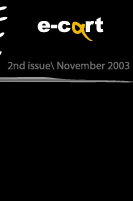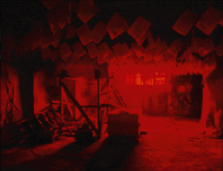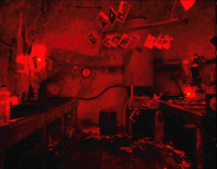















MAGAZIN in the Buyuk Valide Han
When originally invited to participate in the Biennial
I proposed a much more technically ambitious piece which involved the conversion
of a traditional wooden Ottoman house into a concrete modernist dwelling -
a sort of lost brutalist form of Kemalist social
architecture. However due to various problems, mainly concerning budget and
planning consent, the idea was quickly passed over.
From the beginning I had envisaged this piece as being
the completion of a trilogy of works that occupied the territory of the faked
ready-made. The first part of this series was "24a, Orwell Street",
a building converted into a disused Reptile House for the Sydney Biennial,
the second a converted 1954 GMC bus; "The Pumpkin Palace",
for the Capp Street Projects show at the CCAC in San Francisco.
After this initial set back I started by travelling to Istanbul to look for a site with which I could work with the new constraints and still keep true to the original objective. With my own previous knowledge of the city and my assistant and guide Burak, I spent 4 days trawling the city for a site. On entering the Valide Han my decision was immediate, and I began to plan a piece that recognized the importance of such a site geographically and historically both in relation to the Biennial and to my own work.
The work which I made is a photographic darkroom, the
scenario is replicated in the style of the other workspaces that occupy most
of the other 83 rooms in the Han. I built Benches, sinks and a rudimentary
plumbing system, furnished the space with old Soviet
photographic equipment and decorated it with salutations to Allah and portraits
of Attaturk. An old wooden floor and staircase were installed in the back
rooms and the windows were replaced with red plexi-glass casting the interior
into a homogenizing glow of red safe light.
I then went about photographing the rest of the building, returning the gaze back upon itself. Each room, corridor, doorway and facade was documented - very much in the way that I would normally photograph one of my previous labyrinthine pieces - the images being developed in black and white and hung to dry from the ceiling.
The work aimed to draw people out from the white cube
spaces of the main Biennial and to invite them to another part of the city,
emphasizing their gaze upon that specific part, an area not geographically
in Asia but still resonant with imagery and sensations of it. The journey
and discovery of the Han was conceived as very much part of the work, as was
the workman-like process of it's production, encouraging the audience to become
lost and confused as to what and where the work actually resided. The piece
borrowed from
literary structures such as the meta-narrative of "1001 Nights",
or the short story by Borges, "Of exactitude of science" which describes
a map of an empire of equal size to that that it portrays; the darkroom acting
as the cartographer or narrator; a short story or
inventory that prefaces the greater whole.
Mike Nelson
|
|
|
|||||||||||||||||||||
|
|
 |
 |
|
|||||||||||||||||||
 |
 |
|
|
|||||||||||||||||||
|
|
 |
 |
|
|||||||||||||||||||
 |
 |
|
|
|||||||||||||||||||
|
|
|
|||||||||||||||||||||
|
|
 |
|
||||||||||||||||||||
|
|
|
|||||||||||||||||||||
|
|
|
|||||||||||||||||||||
|
|
|
|
|
|||||||||||||||||||
|
|
|
|
|
|||||||||||||||||||
|
|
|
|
|
|||||||||||||||||||
|
|
|
|||||||||||||||||||||
| |
|
|
||||||||||||||||||||
 |
|
|||||||||||||||||||||
|
|
|
|
||||||||||||||||||||
|
|
|
|||||||||||||||||||||
|
|
|
|||||||||||||||||||||
|
|
 |
 |
|
|||||||||||||||||||
|
|
 |
 |
|
|||||||||||||||||||
|
|
 |
|
||||||||||||||||||||
 |
|
|||||||||||||||||||||
|
|
|
|||||||||||||||||||||
|
|
|
|||||||||||||||||||||
|
|
|
|
|
|
|
|
|
|
|
|
|
|
|
|
|
|
|
|
|
|
|
|